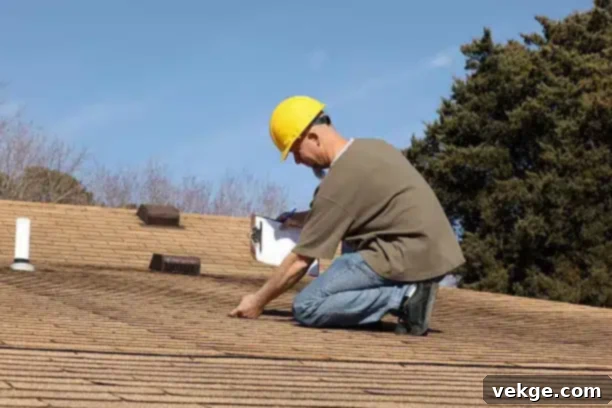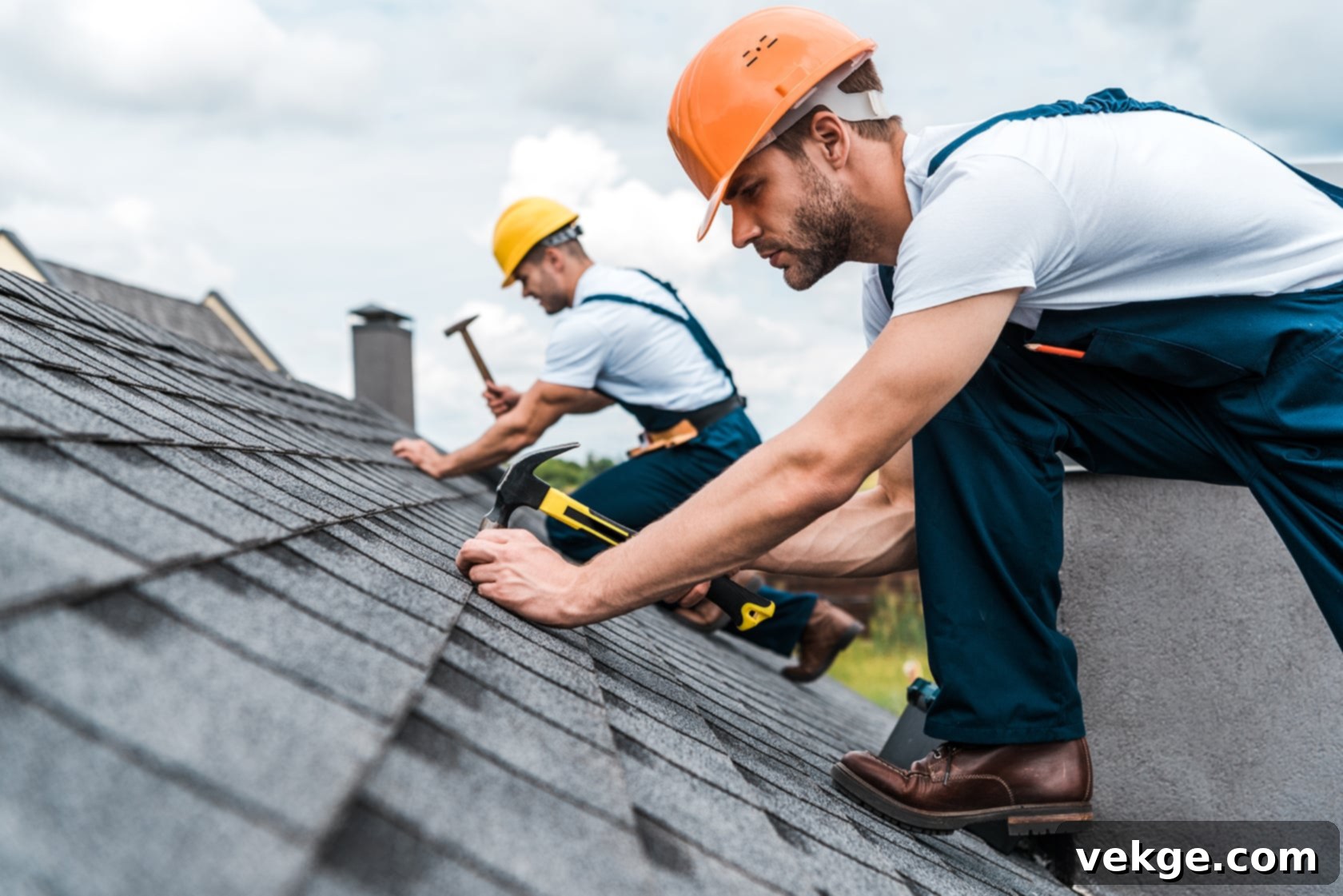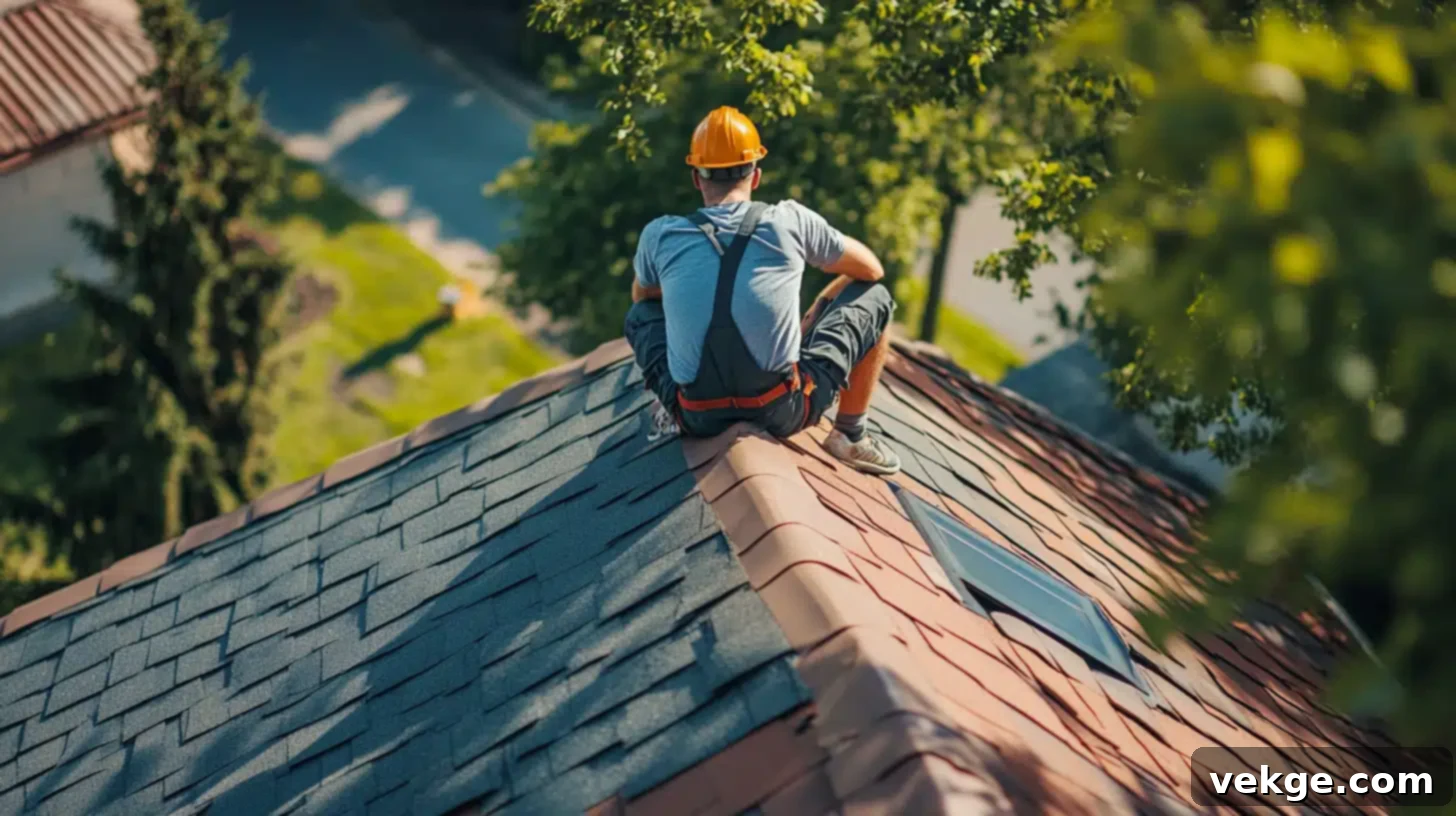Ultimate Roof Maintenance Checklist: Protect Your Home & Extend Roof Lifespan
You’ll often hear the saying, “You are lucky to have a roof over your head,” or some variation of it. However, there’s more to it than that. A roof over your head is important, but having it be a safe, well-maintained, and durable roof is even more crucial for your home’s integrity and your family’s safety.
Your roof is your home’s first line of defense against the elements, from scorching sun and torrential rain to heavy snow and strong winds. Neglecting its upkeep can lead to costly repairs, premature replacement, and even structural damage to your entire home. Conversely, a proactive approach to roof maintenance can significantly extend its lifespan, enhance your property’s value, and provide invaluable peace of mind. Regular, consistent roof care helps prevent minor issues from escalating into major problems, saving you money and stress in the long run. This comprehensive roofing maintenance checklist is designed to empower homeowners with the knowledge and steps needed to keep their roof in optimal condition, ensuring its longevity and protecting your most valuable asset.
Regular Roof Inspections: Your First Line of Defense

The foundation of effective roof maintenance is regular inspection. This proactive approach helps you identify minor issues before they become significant and costly problems. By routinely checking your roof, you can catch damage early, address vulnerabilities, and ensure its continued performance. If you’re uncomfortable or lack the time to conduct these inspections yourself, consider contacting a reputable company that offers professional roofing services. Their expertise can provide a thorough assessment and peace of mind.
Bi-Annual Roof Inspections: Seasonal Checks
It’s essential to conduct thorough roof inspections at least twice a year, ideally in the spring and fall. These periods are chosen strategically: spring allows you to assess and repair any damage caused by winter’s harsh weather, while fall prepares your roof for the upcoming cold and potential snow. During these inspections, pay close attention to critical components such as shingles, flashing, gutters, and downspouts.
- Shingles: Carefully check for any missing, cracked, curled, buckled, or blistered shingles. These are clear indicators of wear and tear or damage. Also, look for signs of granule loss, which often appears as dark, bare spots on the shingles or an accumulation of granules in your gutters. Granules protect shingles from UV rays, and their loss can significantly reduce shingle lifespan.
- Flashing: Inspect the metal pieces (flashing) around chimneys, vents, skylights, and valleys. Ensure they are intact, securely sealed, and free from rust, corrosion, or lifting. Compromised flashing is a common entry point for water leaks.
- Gutters and Downspouts: Verify that your gutters are securely attached to the roofline and are not sagging or pulling away. Check for any obvious signs of damage or dislodgement. Ensure downspouts are properly oriented to direct water away from your home’s foundation.
- Roof Decking and Soffits: From the ground, look for any signs of sagging in the roofline, which could indicate structural issues with the decking. Inspect soffits and fascia for signs of rot, water damage, or pest intrusion.
Post-Storm Inspections: Immediate Damage Assessment
You absolutely must check your roof after experiencing any severe weather events like heavy storms, high winds, hail, or significant snowfall. Immediate inspection can prevent minor, post-storm damage from developing into major structural problems or leaks. When conducting your post-storm roof inspection, be vigilant for various forms of damage:
- Missing or Damaged Shingles: High winds are notorious for tearing off or lifting shingles, exposing the underlying layers to moisture. Look for obvious gaps or displaced shingles.
- Granule Loss: Hail impact often causes widespread granule loss from asphalt shingles, leaving dimpled or bruised areas. This granular material may collect in your gutters or on the ground around your home.
- Visible Damage to Components: Inspect vents, chimneys, and skylights for cracks, dents, or dislodgement caused by flying debris or hail. Check your gutters and downspouts for dents or detachment.
- Leaks and Water Infiltration: Always check your attic or the uppermost ceilings for any signs of water infiltration, such as damp spots, water stains, mold growth, or a musty odor. Even a small leak can lead to significant interior damage over time if left unaddressed.
Comprehensive Cleaning and Maintenance Strategies

Clearing Debris: Preventing Accumulation and Damage
Keeping your roof free of debris is critical for its longevity and performance. Accumulated leaves, branches, dirt, and other organic matter can retain moisture, leading to several detrimental issues. This constant dampness creates an ideal environment for mold, mildew, and algae growth, which can accelerate the deterioration of roofing materials and even cause rot. Additionally, debris adds unnecessary weight to your roof and can block water flow, creating standing water that seeps into seams and under shingles.
Regularly clean gutters and downspouts to prevent clogs. Clogged gutters cause water to back up, overflow, and pool along your roofline, potentially damaging fascia boards, soffits, and even your home’s foundation. Furthermore, remove leaves, branches, and other debris from the main roof surface. For this task, use a soft-bristle broom or a leaf blower to avoid damaging the shingles. Always prioritize safety when working on a roof, using a stable ladder and, if necessary, a safety harness, or hiring professionals.
Moss and Algae Removal: Protecting Shingle Integrity
Moss and algae commonly grow on roofs, especially in shaded, damp areas or climates with high humidity. These organisms aren’t just an aesthetic problem; they pose a real threat to your roof’s integrity. Moss, in particular, acts like a sponge, retaining moisture against the shingles. This continuous dampness can cause shingles to lift, curl, and deteriorate prematurely, making them vulnerable to wind and water damage. Algae, while less structurally damaging than moss, can also hold moisture and contribute to shingle degradation over time, besides leaving unsightly black streaks.
To safely remove moss, you can use a specially formulated moss removal solution. Apply it according to the manufacturer’s instructions, then gently scrub the moss from the roof using a soft-bristle brush. It’s crucial to avoid using a pressure washer, as its high force can dislodge granules, lift shingles, and force water underneath them, causing significant damage. After removal, consider applying an algaecide or a diluted mixture of water and bleach (e.g., one part bleach to two parts water) to affected areas to prevent recurrence. When applying these solutions, be mindful of runoff and take precautions to protect your landscaping, plants, and surrounding property.
Essential Structural Maintenance and Leak Prevention

Checking for Leaks: Early Detection is Key
One of the most critical aspects of roof maintenance is vigilant leak detection. Water leaks, even minor ones, can lead to extensive and costly damage if not addressed promptly. Regularly inspect your attic for any signs of leaks, such as water stains on the wood decking or insulation, mold or mildew growth, or a persistent musty odor. These are clear indicators of water infiltration.
Beyond the attic, also be on the lookout for water stains on ceilings and walls inside your living spaces, which can indicate a roof leak, or sometimes plumbing leaks. Externally, check the roof surface and flashing for any visible cracks, gaps, or deteriorated seals that could allow water to enter. Common leak-prone areas include around chimneys, skylights, vent pipes, and in valleys where two roof planes meet. Even small pinholes can eventually lead to significant water damage.
Inspecting Roof Components: Maintaining Integrity
The various components of your roof work together to form a protective barrier. Ensuring all these parts are in good condition is vital for maintaining the overall integrity and longevity of your roof. Here are some key parts you need to pay particular attention to:
- Flashings: Inspect and repair any damaged, loose, rusted, or missing flashings around chimneys, vent pipes, and skylights. Flashings are specialized metal or rubber seals that create a watertight barrier where the roof meets other structures. They are absolutely crucial for preventing water infiltration at these vulnerable points.
- Vents: Make sure all roof vents (including plumbing vents, attic vents, and exhaust vents) are clear of debris, undamaged, and securely attached. Proper ventilation is essential for regulating attic temperature and preventing moisture buildup, which can lead to wood rot, mold, and reduced insulation effectiveness.
- Skylights: Check the seals around skylights thoroughly to ensure they are watertight and free of cracks or deterioration. Inspect the glass for any chips or cracks, and ensure the frame is secure. Over time, UV exposure can degrade skylight seals, making them susceptible to leaks.
- Chimneys: Beyond flashing, inspect the chimney itself. Check the mortar joints for cracks or crumbling, which can allow water to seep in. Ensure the chimney cap is intact and properly diverting water.
- Fascia and Soffits: Inspect the wood fascia boards (where gutters attach) and the soffits (the underside of the eaves) for signs of water damage, rot, or pest entry. These components are critical for ventilation and protecting the roof edge.
Strategic Seasonal Preparations for Roof Longevity
Preparing for Winter: Combating Cold and Moisture
Winter can be incredibly harsh on roofs, with freezing temperatures, heavy snow, and ice posing significant threats. Proper preparation for the cold months ahead is essential to prevent costly damage. One of the most common and destructive winter problems is the formation of ice dams, which can cause water to back up under shingles and into your home.
- Attic Insulation and Ventilation: Before winter arrives, ensure that your attic is properly insulated and has adequate ventilation. Good insulation keeps heat in your living space and out of your attic, while proper ventilation allows any trapped heat to escape. This combination helps maintain a consistent attic temperature, which is crucial for preventing ice dams from forming.
- Gutter Cleaning: Perform a final thorough cleaning of your gutters and downspouts in late fall to ensure they are completely free of leaves, twigs, and other debris. Clogged gutters prevent melting snow from draining properly, contributing to ice dam formation.
- Snow and Ice Removal: During winter, if heavy snow accumulates, consider safely using a roof rake (from the ground) to remove excess snow and ice buildup from the lower edges of your roof. This can help prevent ice dams and reduce the overall weight on your roof structure.
Preparing for Summer: Mitigating Heat and UV Damage
While winter presents obvious challenges, summer heat and intense UV radiation can also take a significant toll on your roof. Preparing your roof for the warmer months is just as important as winterization.
- Post-Winter/Spring Damage Check: Before the summer heat fully sets in, conduct an inspection for any damage that might have occurred during winter and spring storms. Address any missing shingles, cracked flashing, or loose components promptly, as the sun’s heat can exacerbate these issues.
- UV Protection: Prolonged exposure to ultraviolet (UV) rays can degrade roofing materials, especially asphalt shingles, causing them to dry out, crack, and lose their protective granules. Consider applying a reflective or elastomeric coating to your roof. These coatings can help protect the roofing materials from UV damage, extend their lifespan, and also reflect sunlight, which can significantly reduce attic temperatures and lower your home’s cooling costs.
- Ventilation Check: Ensure your attic ventilation system is functioning optimally. Good attic ventilation is vital in summer to expel superheated air, which protects your roof decking from premature aging and keeps your home cooler.
The Value of Professional Roof Maintenance
Hiring a Professional Roofer: Expert Eye and Safety
While regular DIY maintenance is undeniably essential for basic upkeep, having a professional roofer inspect your roof annually can provide an invaluable layer of protection. A professional brings an expert eye, capable of identifying subtle issues that might go unnoticed by an untrained homeowner. They possess the specialized knowledge to diagnose potential problems accurately and offer effective, long-lasting solutions.
A professional roofer has the expertise to identify and address complex problems that may not be visible or understandable to the untrained eye, such as subtle structural issues, flashing defects, or early signs of material fatigue. Furthermore, they are equipped with specialized tools and adhere to strict safety protocols, reducing the risks associated with working at heights. They can handle more complex repairs and maintenance tasks, from sealing intricate flashing to addressing ventilation problems, ensuring the job is done correctly and safely. Investing in an annual professional inspection is an investment in your home’s long-term health and your peace of mind.
Maintaining Warranties: Protecting Your Investment
If your roof is under warranty – whether it’s a manufacturer’s warranty on materials or a contractor’s warranty on workmanship – regular professional inspections and maintenance are often crucial for ensuring that you remain in compliance with the warranty terms. Failing to adhere to these requirements could void your warranty, leaving you responsible for costly repairs that would otherwise be covered.
Many roofing warranties explicitly require regular maintenance and documented inspections to remain valid. It’s imperative to read your warranty documents carefully to understand these stipulations. To protect your investment, keep detailed records of all inspections and maintenance activities, including dates, names of professionals, specific tasks performed, and any costs incurred. This documentation serves as proof of compliance should you ever need to file a warranty claim. A professional roofing contractor can also help you understand your warranty’s specifics and ensure all maintenance is performed according to its guidelines.
Conclusion: A Proactive Approach to Roof Care
Your roof is much more than just a covering; it’s a vital component of your home’s structural integrity, energy efficiency, and overall safety. By diligently following this comprehensive roof maintenance checklist, you are not just performing tasks; you are making a crucial investment in the longevity and value of your property. From bi-annual visual inspections and immediate post-storm checks to meticulous cleaning, structural vigilance, and seasonal preparations, every step contributes to a healthier, more durable roof.
Remember that while DIY efforts are commendable and effective for many aspects of roof care, the expertise of a professional roofer for annual inspections and complex repairs is invaluable. They can spot hidden issues, ensure proper repairs, and help you maintain compliance with your roof’s warranty. Embracing a proactive approach to roof maintenance will not only prevent costly emergencies and extend your roof’s lifespan but also provide you with the comfort and peace of mind that comes from knowing your home is well-protected against the elements. Don’t wait for a problem to appear; take action today to keep your roof in top condition for years to come.
